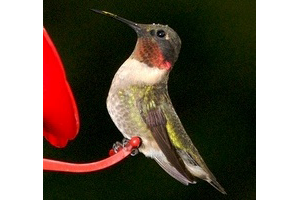Many ruby-throated hummingbirds fly nonstop across the Gulf of Mexico during fall and spring migration. To power this flight, individuals may put on enough fat to double their body mass prior to departure.
Photo Credit: Bill Read
Archilochus colubris
Common Name: ruby-throated hummingbird
Animal Guild: Bird
Class > Order > Family: Aves > Apodiformes > Trochilidae
What does the species look like?
In most of the breeding range this is the only hummingbird, so identification is easy. Adult males have a brilliant red throat and bronze-green back. Adult females have a grayish white throat, usually green crown, and a bronze-green back. Some older females may have up to several red feathers on the throat. Juveniles resemble adult females, but subadult males in autumn may show some red in the throat. Length is about 3.75 inches (7.5-9 cm).
Where is the species found?
States & Provinces
AB, AL, AR, BC, CT, DE, FL, GA, IA, IL, IN, KS, KY, LA, MA, MB, MD, ME, MI, MN, MO, MS, NB, NC, ND, NE, NH, NJ, NL, NS, NY, OH, OK, ON, PA, PE, QC, RI, SC, SD, SK, TN, TX, VA, VT, WI, WV
Distribution
Breeding range extends from central Alberta east across southern Canada to Nova Scotia, and south, east of Rockies, to southern Texas, Gulf Coast, and southern Florida, and west to eastern Dakotas, central Nebraska, central Kansas, central Oklahoma, and central Texas. The winter range includes the Pacific slope of Mexico from southern Sinaloa south, and the Caribbean slope from southern Veracruz, Yucatan Peninsula, and Oaxaca south to central Costa Rica, casually to western Panama. Small numbers occur along the Gulf Coast from southeastern Texas to northwestern Florida and in southern Florida.
Breeding habitat includes both heavily-wooded and open deciduous, mixed pine-hardwood, or pine forests, forest edge, savannas, wetlands, orchards, parks, wooded yards, and gardens. Nests are typically constructed near the tip of a downward-sloping branch, 0.5-15 meters (2-50 feet) above the ground or water and are often sheltered overhead by leaves but open below. During migration, this hummingbird uses habitats similar in structure to those used for breeding, including brushy second growth, deciduous forest, tropical dry forest, tropical deciduous forest, gallery forest, shade trees in coffee plantations and yards, flowering hedges, and citrus groves.
General Phenology and Life History
Early spring migrants begin arriving on the northern Gulf Coast in late February, although most birds arrive in March and early April. Peak spring arrival time is mid-April in the Midwest, early May in the Great Lakes region, and mid-May in the northeastern states. Spring migration overlaps with peak flowering of some, but not all, important nectar-producing plant species. Spring migrants arrive at the northern end of the breeding range 3-4 weeks before any herbaceous flowers are in bloom. These individuals rely heavily on tree sap obtained at yellow-bellied sapsucker holes. Fall migration begins in early August at the northern end of the breeding range. In Alabama, peak migration occurs between mid-August and early September. Fall migration is nearly synchronous with flowering of jewelweed. Males precede females during both migrations. Migrants fly across the Gulf of Mexico and along the western Gulf Coast. Egg-laying dates range from late March through early September; earliest clutches are laid in the deep south, the latest in the north. Clutch size is nearly always two, but clutches of one or three eggs have been reported. Eggs are laid 1-3 days apart; incubation begins after the first egg is laid. Incubation, by the female only, lasts 12-17 days. Eggs hatch over a period of 1-3 days. Brooding and feeding of young is by the female only. Young fledge in 18-22 days. Individual females often produce two or sometimes three broods per year.
Which phenophases should I observe?
Do you see/hear...?
Activity
Live individuals More...
For abundance, enter the number of individual animals observed in this phenophase.
Feeding For abundance, enter the number of individual animals observed in this phenophase.
Insect consumption For abundance, enter the number of individual animals observed in this phenophase.
Flower visitation For abundance, enter the number of individual animals observed in this phenophase.
Calls or song For abundance, enter the number of individual animals observed in this phenophase.
Singing individuals For abundance, enter the number of individual animals observed in this phenophase.
Territorial individuals For abundance, enter the number of individual animals observed in this phenophase.
Reproduction
Courtship For abundance, enter the number of individual animals observed in this phenophase.
Mating For abundance, enter the number of individual animals observed in this phenophase.
Nest building For abundance, enter the number of individual animals observed in this phenophase.
Occupied nest For abundance, enter the number of individual animals observed in this phenophase.
Development
Nestlings For abundance, enter the number of individual animals observed in this phenophase.
Fledged young For abundance, enter the number of individual animals observed in this phenophase.
Dead individuals For abundance, enter the number of individual animals observed in this phenophase.
Dead nestlings or fledglings For abundance, enter the number of individual animals observed in this phenophase.
Method
Individuals at a feeding station For abundance, enter the number of individual animals observed in this phenophase.
What do these phenophases look like?
There is currently no photoguide available for this species. If you'd like help us create one, use the guidance document and species template provided here . Then send it via email to education@usanpn.org when it is complete.
